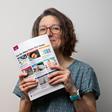What better time to talk about boys, and get boys talking than International Women’s Day?
International Women’s Day (IWD) is 8 March. While the usual jokes (when’s International Men’s Day? Thanks, Richard Herring for sorting that one out) do the rounds, IWD isn’t simply about women. It’s about equality. This year, IWD’s call is Balance for better – calling for a gender-balanced world, a world where gender is irrelevant.

Applying that to chemistry, science and education, it’s time to recognise the parts we can all play – those in industry; at the helm of organisations like the Royal Society of Chemistry, Royal Society of Biology and Institute of Physics; universities; schools; teachers; teacher trainers; and pupils. Equality in the sciences, in schools and in society won’t happen if we’re only talking to and including women and girls in that conversation. Men and boys should be included. And by included, I mean in conversations and representations.
For teachers and students, how we talk about science and STEM and the images we use in those conversations play a pivotal role in ensuring today’s students don’t perpetuate the status quo. The old adage that you can’t be what you can’t see is important. Thankfully for all students today, they can and do see women winning prizes for science (Donna Strickland and Frances Arnold, being the two obvious recent examples), at the head of organisations like the Royal Society of Chemistry (Carol Robinson; similarly Julia Goodfellow at the Royal Society of Biology and Julia Higgins, the Institute of Physics) and on television talking about science (Alice Roberts, Cancer Research UK’s Fran Balkwill). This is just as important for boys to see as girls.
Ask yourself (and answer honestly), do you always use gender neutral or equal language?
Today’s students also see women and men teaching in school. In fact according to Department of Education figures from 2017’s School workforce census, around three-quarters of teaching staff in English state-funded schools (primary and secondary) were female. Dig further into the statistics though (well those that are readily available) and the most recent details I can find on the gender balance in science teaching is from 2007, in a Royal Society report, The UK’s science and mathematics teaching workforce. Of 8893 maths and science teachers, women were slightly in the majority – 4453. But most of those were part-time, so on balance, it’s still more likely that as a school student you’ll see men teaching science.
As important as who you see teaching and doing science is the language we all use to talk about science and who does it. Ask yourself (and answer honestly), do you always use gender neutral or equal language? Only by remaining vigilant and saying headteacher, not headmaster or mistress; doctor, not woman doctor; and nurse, not male nurse can we begin to hope that today’s students will grow up with the belief that gender doesn’t influence occupation, or passion.
When you next hear John Humphrys on BBC Radio 4 say female scientist, don’t feel gratified that he used female rather than woman or girl, get righteously upset that he felt the need to specify. Let’s encourage all students to call out sexism. It’s not a fight that girls should be fighting alone.












1 Reader's comment